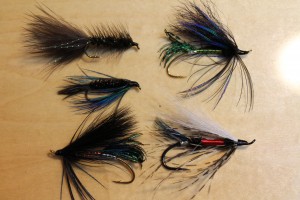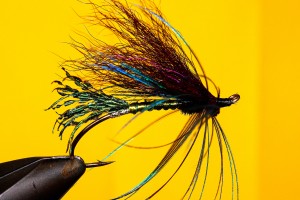 There was a time when I tied flies a lot. Almost every night in my smoky one room apartment you would find me drinking cheap beer and adding to my inexhaustible supply of flies. There were, and still are, certain flies that I can’t ever seem to have enough of—things like trout and steelhead nymphs or smallmouth poppers are good examples of flies that even today I need to keep after. But back then I worked at a fly shop, surrounded by the finest tying materials and hooks for most of my day. Since tying materials are pretty cheap, it was easy enough for me to constantly augment my supply of fur, feathers and synthetics. It was a pretty simple, yet enjoyable existence. The fun of tying more tarpon flies than 100 guys could use in a 100 years. I wish I had some pictures of the old apartment. I’m sure that it resembled a cross between a homeless shelter and a tackle shop. In fact one night a friend crashed on my floor, he complained the next morning that when he woke up he had rolled onto a pile of crankbaits.
There was a time when I tied flies a lot. Almost every night in my smoky one room apartment you would find me drinking cheap beer and adding to my inexhaustible supply of flies. There were, and still are, certain flies that I can’t ever seem to have enough of—things like trout and steelhead nymphs or smallmouth poppers are good examples of flies that even today I need to keep after. But back then I worked at a fly shop, surrounded by the finest tying materials and hooks for most of my day. Since tying materials are pretty cheap, it was easy enough for me to constantly augment my supply of fur, feathers and synthetics. It was a pretty simple, yet enjoyable existence. The fun of tying more tarpon flies than 100 guys could use in a 100 years. I wish I had some pictures of the old apartment. I’m sure that it resembled a cross between a homeless shelter and a tackle shop. In fact one night a friend crashed on my floor, he complained the next morning that when he woke up he had rolled onto a pile of crankbaits.
Somewhere along the way it appears that the smoky apartment has been replaced by a nice house, a wife and two kids have appeared, and the never ending 12 packs of cheap beer has been replaced by a couple of Summits. And while I still tie flies out of necessity, my nights of “recreational tying” are mostly a thing of the past. I now have a designated fly tying room, which makes it possible to get tying right away when the mood strikes.
Despite the thousands of flies I have tied, I still don’t consider myself to be a great tyer. If you need some durable, effective flies tied up in a hurry, then I’m your man. If you looking for a dozen that look just like the ones in the catalogs and on-line websites, please look elsewhere. I figured out at an early age that a simple scruffy fly will work just as well, and maybe better than an ultra-realistic fly, tied with jointed legs, antenna, eyes, genitalia, DNA sequencing, etc. Case in point—I was about 10 or 11, I’ve caught a whole lotta trout by this time in my life, but all on worms, a few on Mepps. My interest in catching a trout on a fly was strong though, and my grandpa would often rig up my Herter’s fly rod for me to flail away at rising trout with. One day I was working up a good froth at the bottom end of our favorite worm dunking hole, and much to everyone’s amazement, I ended up with a good sized trout on the line. The fly that I was using was one my grandpa called the “Black Nothing”, probably because it was just black fur on a hook. After the capture, he cleaned the trout streamside and showed me that it had several black beetles in its stomach. “That’s why it ate your black fly” he said, “it thought it was another one of these beetles”. Alright, black fur on a hook = beetle. Got it. I had simplified matching the hatch and flyting before it ever had a chance to get complicated on me.
So, combine that with my natural lack of artistic ability, and you’ve got a guy that is going to tie a fly that is good enough catch fish, but no better. In an hour, I can get well over a dozen of my scruffy specials done. On the other hand, someone who might be considered a “great” tyer, would probably be able to get half that many done. They would likely be perfect ties, but would they catch any more fish than the stuff I tie and fish with?
My friend JD “Redfern” LeCompte contacted me from his California ranch recently, letting me know he had an abundance of peacock feathers he had gleaned from their semi-tame flock, wondered if I could use them for fly tying. He sent a couple of pics of the plumage he had gathered, much of it was pretty standard tying stuff– eyed plumes and some swords, stuff that is easy to come by. But some of the feathers were stuff I had never seen before, and I wasn’t sure how I could use them. A week or so later I had an envelope in my mailbox that was overflowing with peacock. I was determined to set aside a night for “recreational tying”. 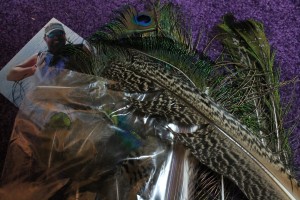
Once you start tying flies, you start looking at the world a little differently. As in “What could I tie with that?” every time you see a rug, a pet, a sweater, or fresh roadkill. An old girlfriend once forbid me to put a skunk tail in the trunk of her car [it only smelled a little—and the hair was really nice and long!], and I still have the tail of an albino squirrel that was dead in the middle of the road in downtown Farmington, Minnesota. Joe Vasquez was with me, we were running late for work on a Sunday after a morning mission to Hay Creek. When I first saw it on the centerline, I figured it was a cat, but as I passed it, nope, that’s a white squirrel—must have! I did a quick U-turn, pulled over and hacked the tail off with a dull knife. We still made it the Orvis store Downtown by 11. That tail is still in my collection.
In the package of peacock, there were some great looking body feathers that I suspected would be choice for tying “Spey” style flies. Spey flies are a traditional style of fly that still have a dedicated following. I’ve never tied very many, and I’ve certainly never fished with them, but they are very attractive. I was able to pull off a few “Spey” or “Spider” patterns that probably won’t see any time on the water, but will look really cool in one of my fly boxes dedicated to such things.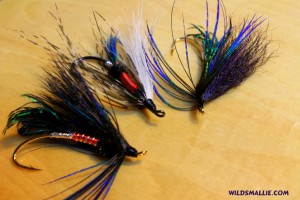
Peacock herl is very useful for tying trout and steelhead nymphs, and this stuff in the package was top notch. A few nymphs and a bugger for good measure will all go into a working box.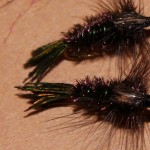
A popular “attractor” pattern here in the Midwest is the “Pass Lake”. It’s sort of a streamer/wet fly that doesn’t really look like anything, but on some days the trout can’t get enough of it. They are traditionally tied with black chenille for the body, but choice peacock herl works as good or better. The wing is supposed to be calf tail, these have the wing crafted of the aforementioned albino squirrel tail. I have always tied them with a red head. It’s fun to stray from my usual tying–only tying stuff I need. Maybe if I did this a little more I could actually become a good fly tyer.
It’s fun to stray from my usual tying–only tying stuff I need. Maybe if I did this a little more I could actually become a good fly tyer.

